After fixing the failed extruder thermistor on my Monoprice Select Mini 3D Printer, it didn’t surprise me at all when the heated bed thermistor also failed. Read on to see how I replaced it.
This is the bottom side of the heated platform. Wire leads from the controller are soldered to it at the rear, with some Kapton tape insulation. The thermistor is a surface mounted component at the center of the platform.
The heated bed thermistor is a surface-mount component in an 0805 package. I suspect that this part failed from mechanical stress, since the bed can flex quite a bit while removing strongly-adhered parts. This kind of component package isn’t suitable for applications where the circuit board will flex a lot.
These are some 100k ohm glass-bead thermistors that I originally purchased for the extruder. Their temperature curve isn’t quite right, so I ended up using a different thermistor for the extruder. The temperature curve difference won’t cause as much error on the bed as it would in the much hotter extruder.
I bent the thermistor leads to allow them to flex without breaking or applying a lot of stress to the glass bead seals. Then I added some Teflon sleeving to insulate them.
I carefully soldered the trimmed ends of the thermistor leads to the original component’s circuit board pads. I placed the thermistor bead over the thermistor traces instead of over the heating traces, to avoid measuring a local hot spot.
I put a tiny dab of thermally-conductive grease between the thermistor bead and the bed, and then I encapsulated the bead with Dow-Corning 748 non-corrosive silicone RTV sealant.
The wire lead connections to the bed could use some better strain relief. They will experience stress with Y axis movement.
I removed the original Kapton tape insulation, and replaced it with a small piece of Kapton tape to mask off the solder joints. If I ever need to get back in there to fix the solder joints, I don’t want the joints contaminated with sealant.
The second, much larger piece of tape is temporary. It will hold the wires in place while the new sealant cures.
I encapsulated the wire lead connections with Dow-Corning 748 non-corrosive silicone RTV sealant to provide electrical insulation and strain relief.
I used this non-corrosive silicone sealant to encapsulate the thermistor and the wire lead connections to the heated platform. Unlike common silicone sealants, it doesn’t release lots of acetic acid while curing.
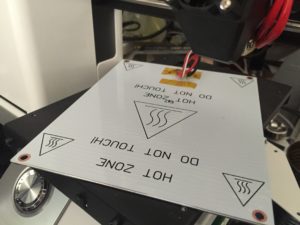
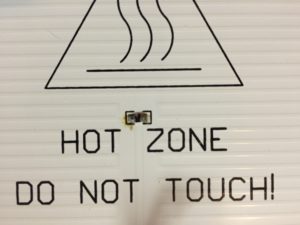
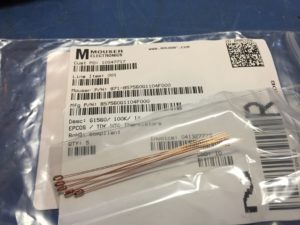
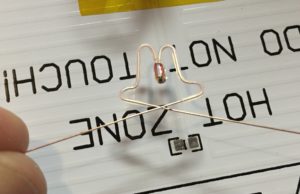
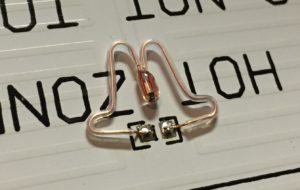
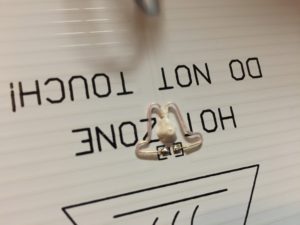
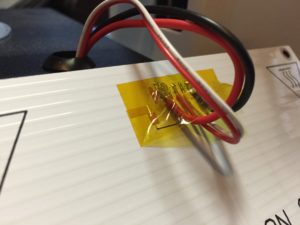
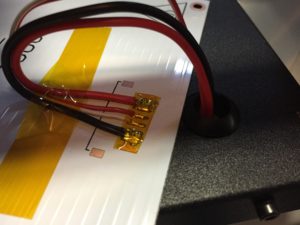
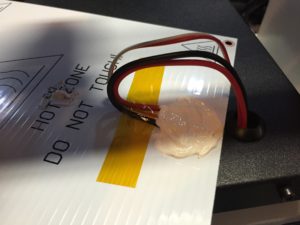
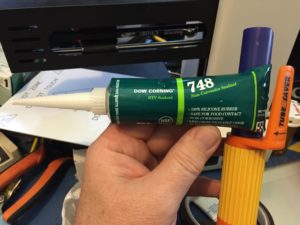
Where do I get a replacement. I’m returning this printer, but just in case I want to make it better than the way they sell this POS.
This is the thermistor that I used:
http://www.mouser.com/ProductDetail/EPCOS-TDK/B57560G1104F000
This thermistor doesn’t seem to exist at Mouser anymore. Would this one be comparable?
https://www.mouser.com/ProductDetail/Littelfuse-US-Sensor/GP104L8F?qs=sGAEpiMZZMuBd0%252BwiCVS22TnLIlDIjZTS%252BbINd811kVULNIT5mmO8Q%3D%3D
Thanks!
It’s probably close enough. Maybe you’ll need to fiddle with your bed temperature setting a little bit.
Ok thanks for this very helpful page!
How did you remove the old thermistor?
With a soldering iron and desoldering braid, just like any other surface-mount resistor. The aluminum bed plate sucks heat away from the solder joints a lot more than a typical circuit board would, so it’s kind of like soldering a component on a big ground plane with no thermal relief.
If you are new to surface mount soldering, then I recommend learning from YouTube videos and practicing on scrap circuit boards. You’ll probably wreck stuff while learning how to control the heat, so wreck junk instead of valuable stuff if at all possible. Good luck!
Nice tutorial, would you fix me up with a “kit” to fix my bed. My bed has been having issues and I need to go ahead and replace the resistor. Has this been working well for you? I would gladly pay if you would send me what I need. If I buy it separate it will most likely cost me more than its worth. My email is Johnegrissom@gmail.com if you want to hit me up there. Thank you and appreciate the tutorial.
Hi. I’m happy that the tutorial was helpful. My fix worked fine, but I upgraded to a fancier machine not long afterwards. I’m not interested in putting together kits, but I linked to the part that I used in another comment. Good luck!
Thanks for the reply and we did basically the same thing lol. I also upgraded a bit to a QIDI machine, however I still want to fix this printer since it actually does a nice job on printing after some community mods and firmware. On you tube the channel “Life and times of Tyler” has some great vids on this printer. Since I am a newbie to this so you think the following would work just as well for the themo sensor? Also would regular RTV sealant wok? The DOW 748 is expensive just for the small dab I need? Thanks again for the help!
THERMO: https://www.amazon.com/gp/product/B01B41K7OM/ref=ox_sc_act_title_2?ie=UTF8&psc=1&smid=A1A5FQE7R5RISB
RTV: https://www.amazon.com/Permatex-81160-High-Temp-Silicone-Gasket/dp/B0002UEN1A/ref=sr_1_2?ie=UTF8&qid=1485719992&sr=8-2&keywords=RTV
That thermistor and sealant would probably work.
Thanks Mark- appreciate the help!
High – Just lost my bed’s heating and the temperatures reported swing rather erratically, it hovers around 18 to 27 degrees celsius but sometimes shows 0 degrees. If I disconnect the thermistor from the controller I see 0 and 999 and a few other low, random values.
As far as i can tell the terminator is still electrically connected to the board. I have plugged my ohms meter into the small plug and get a value around 500K.
What I was wondering was, if the thermistor is faulty, will this stop the controller from powering up the heater?
I have checked the wiring to the heater and there are no breaks but when the printer is set to preheat the bed, the controller only sends about 30 millivolts to the heater. My first thoughts was that something in the controller is fried or the JFET that powers the heater is dead.
I’m replacing the printer with Amazon because it’s brand new but it would be great to understand how the controller responds to a faulty thermistor for later if I have this problem in the future.
That behavior sounds like the thermistor is intermittently open. I think that your bed thermistor is probably cracked. It’s a design issue, in my opinion: They used a surface mount package thermistor on a flexible substrate (the thin aluminum bed) which is subject to a lot of flexing when you remove prints, and that thermistor just isn’t designed to survive that kind of mechanical stress.
I don’t remember exactly how my printer behaved, but I seem to recall that the controller reported an error when the extruder thermistor failed, and just stopped heating the bed when the bed thermistor failed. In both cases, I think it was smart enough to not burn the printer up by running the corresponding heater open-loop.
The 30mV that you measured is probably just due to leakage current through the MOSFET that drives the bed heater.
If (well, probably when) the bed thermistor eventually fails out of warranty on the replacement printer, I recommend replacing it with something that should be able to survive severe bed flex without breaking, like I did. Or just get a dozen exact replacement thermistors, and plan to replace it occasionally.
Thanks.
Your comments make sense to me and once I have the new printer from Amazon, I’m going to invest in some 100K thermistors.
I have been using a 3mm glass plate on the top of the Aluminum bed (with the Z Height mod installed) and notice that the Aluminium bed can become distorted when the springs are tightened unevenly.
This is probably why many people find their beds distorted.
I’m thinking of printing some ABS stabilising rails to clamp on the front and back of the Aluminium bed to try and stiffen it and control this distortion. It would be good to have rails on the sides of the bed too but the bearing, support blocks under the bed makes this impossible (I think).
If these rails work, I might see what getting them machined in Aluminium would cost. I expect ABS will either be too flexible or will warp overtime from the heat of the bed.
It took me quite sometime to: one, understand what was causing the glass to rock on the bed and then; two, get the glass plate to lay flat and have it leveled to the nozzle tip at all four corners of the bed. (My bed appears to develop a hump from the back-left to the front-front corners of the bed just as the bed is close to being leveled, very aggravating).
I’m also going to experiment with increasing the Z Height Adjustment to allow me to just tighten down the levelling screws to level the bed. This should reduce the pressure on the bed and may remove the distortion that I’m seeing.
I took the aluminium bed off to check if it was flat during all of the above and this is when the bed stopped working. So I gather the thermistor broke during this time.
My MP Select Mini v1 is only a few weeks old and I see that the way the bed is now wired has been improved, with the wires attached via a flexible tie under the bed and an oval grommet into the main body of the printer, much better than what I’ve seen in the older models.
I’m glad to hear that they are improving the design and construction. I don’t regret upgrading to a better printer at all, but I think it’s great that the availability of machines like the Mini is making additive manufacturing more accessible to more people. Isn’t it cool living in the future?
I made a replacement enclosure for my truck’s door lock remote out of PLA with my Mini, and it’s been banging against my keys in my pocket for about a year. It’s still holding together just fine.
Good luck with your bed upgrades!
Just a follow up on my attempts to overcome the bed distortion:
My attempts to reduce the spring tension on the bed, with the hop to reduce any resultant distortion, were unsuccessful. The springs are not the issue, the issue is that the aluminium bed is too flimsy. I might consider epoxy glueing some aluminium rails under the outer edges of the bed, on the new MP Mini, if it too has this distortion issue.
By the use of good luck and black magic I have seem to have got my bed to be level and not have the glass sheet rocking on it.
I really hope the new one is not as frustrating to level.
Just a follow up on my attempts to overcome the bed distortion:
My attempts to reduce the spring tension on the bed, with the hop to reduce any resultant distortion, were unsuccessful. The springs are not the issue, the issue is that the aluminium bed is too flimsy. I might consider epoxy glueing some aluminium rails under the outer edges of the bed, on the new MP Mini, if it too has this distortion issue.
By the use of good luck and black magic I have seem to have got my bed to be level and not have the glass sheet rocking on it.
I really hope the new one is not as frustrating to level.
Mark just a real quick reply, I found out that if you actually adhear the glass bed to the build plate it will take the flex out of the plate allowing you to have a smooth / level / flat surface. Since the glass is rigid it takes the flex out of the aluminum plate. I cut about 1/4 wide 3M sheet adhesive strips and put them around all 4 sides. I’ll take a picture of what I did this evening. I have already been down all the other avenues and this has always worked. The only side effect is that the glass will be permanently glued in place, I always use painters tape or similar between the glass and bed so I can remove the glass if needed in the future.
Do you mean that you tape the glass from the top side of the glass around the side and underneath? Or do you tap it between the bottom of the glass and the top of the bed?
I like the first approach as long as the tape stay outside of the print area it might have enough strength to overcome the distortion.
The second approach would create an air gap and interfer with heat transfer from the aluminium bed to the glass.
Either way would work however I actually use the 3M adhesive sheet between the glass and printed. I use the painters tape or PEI on the bed that way in case I wish to remove the glass down the road I am able to do so. I realize that part of the appeal of having a glass bed is also removing it once a print is finished for ease of print removal however since the prints release almost automatically once the glass cools I don’t find this to be much of an issue.
I used these sheets and cuts stupa like. I mentioned. But anything similar would work. Just make sure you can access the bed leveling screws by cutting 45 degree corners on the glass for screw access.
Gizmo Dorks 3M 468MP Adhesive Transfer Tape Sheets 10″ x 10″ (5-Pack)
https://www.amazon.com/dp/B01JPWSY6A/ref=cm_sw_r_sms_apa_hX.pzb5QS945J
Either way would work however I actually use the 3M adhesive sheet between the glass and printed. I use the painters tape or PEI on the bed that way in case I wish to remove the glass down the road I am able to do so. I realize that part of the appeal of having a glass bed is also removing it once a print is finished for ease of print removal however since the prints release almost automatically once the glass cools I don’t find this to be much of an issue.
I used these sheets and cuts stupa like. I mentioned. But anything similar would work. Just make sure you can access the bed leveling screws by cutting 45 degree corners on the glass for screw access.
Gizmo Dorks 3M 468MP Adhesive Transfer Tape Sheets 10″ x 10″ (5-Pack)
https://www.amazon.com/dp/B01JPWSY6A/ref=cm_sw_r_sms_apa_hX.pzb5QS945J
Either way would work however I actually use the 3M adhesive sheet between the glass and print bed. I use the painters tape or PEI on the bed that way in case I wish to remove the glass down the road I am able to do so. I realize that part of the appeal of having a glass bed is also removing it once a print is finished for ease of print removal however since the prints release almost automatically once the glass cools I don’t find this to be much of an issue.
I used these sheets and cuts strips like I mentioned. But anything similar would work. Just make sure you can access the bed leveling screws by cutting 45 degree corners on the glass for screw access.
Gizmo Dorks 3M 468MP Adhesive Transfer Tape Sheets 10″ x 10″ (5-Pack)
https://www.amazon.com/dp/B01JPWSY6A/ref=cm_sw_r_sms_apa_hX.pzb5QS945J
I have two of these printers, one of which just finally stopped reading the heat bed temp entirely, the second one looks like it won’t be far behind, so I wanted to try this out… Finding the Thermistors with no problem, but not able to find the teflon sleeving you used… I look up teflon tubing, and EVERYTHING is bowden tubing… I am guessing you used something MUCH smaller than that to insulate the wires of the thermistor… Any suggestions where to find that?
A common name for the Teflon sleeving that I used is “spaghetti tubing“.
I’ve put a glass surface over the aluminum bed. Is it worth my time to try to repair the heated bed or is it going to do a poor job of heating the glass anyway?
Thanks for sharing this repair. I was printing one day, heard a pop, and saw some smoke come out from under the bed. Then my bed temperatures now show 349c even if no heating is turned on. Everything looked like it was a thermistor problem. Ordered some 100k resisters and just now soldered one on, still getting 349c for a bed temp. Resistance reading of the thermistor from the plug on the control board (disconnected) reads a little over 100k (normal), so I know I continuity from the plug through the thermistor and back. So I’ve started checking voltages to the thermistor and I only get 3v DC at the thermistor connections? Is this enough voltage? Could my control board be bad? I don’t see any physical damage to the board, no burn marks any way. Can’t help but think that maybe the smoke I saw coming up from the bed was actually coming from inside the unit from the control board. Thanks for any help you may give.
Were you able to resolve this? My MPSM just started showing bed temps that jump anywhere from 0-15C. Ambient is more like 25C. Unplugged it reads 999, so I’m thinking my bed temp sensor is shorting internally.
Yes, replacing my bed thermistor got my printer working again. I didn’t end up using this printer too much more before I upgraded to a much bigger printer (Makergear M2), but I think that the way I fixed the thermistors should improve reliability by relieving stress on the wire leads.
I found that I most likely have a motherboard problem. Given that the thermistor is in the ~100k range, I took a 100k resister and soldered it to a 2 prong plug that fit the MB socket that the bed sensor connects to. The display now floats around between 19-24C. With a fixed resistance the reading should be relatively stable. I checked the resistance of the bed sensor while disconnected from the MB and the printer powered on. The resistance of the bed sensor started out at ~195k ohms and dropped to ~108k ohm as the bed temp approached 80C when set to 50C (keep in mind, the MB did not know actual bed temp).
I also checked the sensor dynamically by reconnecting it to the MB and placed the DVOM across the sensor leads while the printer was powered up. The voltage across the sensor wires when at room temp (~25C) was right around 3.23v and was very stable. As the bed temperature approached 80C the voltage dropped to ~3.12v. Again, this voltage was stable.That doesn’t seem like a lot but an Arduino based board can map that range to 1024 data points.
Anyway, I think the MB is trash.
Does anyone know what the resistance of the heated bed should be? I am measuring 1.7 ohms. At 12V that amounts to just over 7 amps for just the bed heater. I bought the printer used and I could not get it to even preheat without shutting down. I noticed the power supply was shutting down on preheat. It is a 10A supply and that seems marginal considering the demands of this bed heater. I was thinking maybe a prior owner changed it with a high wattage or something. Any help would be awesome. BTW I have the Malyan M320 version of the printer.